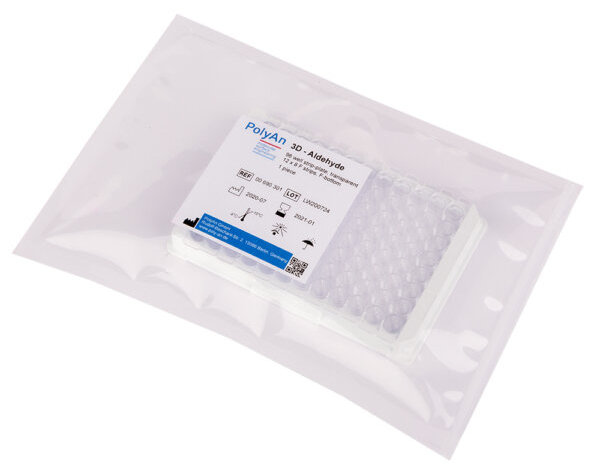
Amine Binding Plates for ELISA
PolyAn´s Amine-binding microplates are useful for immobilizing biomolecules that inefficiently coat by passive adsorption. PolyAn offers amine-binding and nucleophilic binding surfaces, providing a convenient method to covalently immobilize biomolecules, e.g. proteins, peptides, amino-modified oligonucleotides or other ligands.
3D-Epoxy and 3D-NHS functionalized ELISA microplates
00 680 251
3D-Epoxy, 100µL functionalisation volume
96 well plate, white, 12 x 8-strip, flat bottom
00 690 251
3D-Epoxy, 100µL functionalisation volume
96 well plate, transparent, 12 x 8-strip, flat bottom
00 690 451
3D-NHS, 100µL functionalisation volume
96 well plate, transparent, 12 x 8-strip, flat bottom
00 695 251
3D-Epoxy, 100µL functionalisation volume
96 well plate ELISA, C-bottom, transparent, 12 x 8 strip
00 695 451
3D-NHS, 100µL functionalisation volume
96 well plate ELISA, C-bottom, transparent, 12 x 8 strip
PolyAn’s 3D-NHS functionalised 96-well microplates are used for covalent immobilisation of biomolecules. The NHS-ester reacts immediately with the NH2- terminus of biochemical species to form a covalent bond with the surface (420 kJ/mol).
00 696 251
3D-Epoxy, 100µL functionalisation volume
96 well plate, U-bottom, transparent
The three-dimensional functional matrix allows the development of covalent binding of nucleophiles to the plate surface without complex coupling chemistry.
- Branched, spacered 3-dimensional polymer
- Simple coupling chemistry
- Directed (bio-orthogonal) immobilization possible
- Economic alternative to streptavidin coated plates
The structure of the matrix, which has a thickness of up to 50 nm, also reduces unspecific binding to a minimum.
ELISA application: IgG-FITC immobilization on PolyAn 3D-surfaces versus a passive/adsorptive binding surface

Customised Plate Surfaces
If you require a special surface for binding of your biomolecules that is not listed in the products table, contact us.
We can also functionalize other plate formats and substrates with our surfaces. Additionally, we have access to a wide range of different surface modifications for binding of small molecules, saccharides etc.


